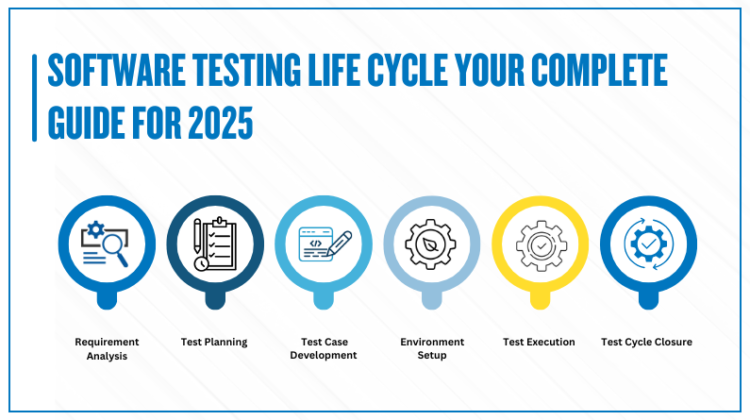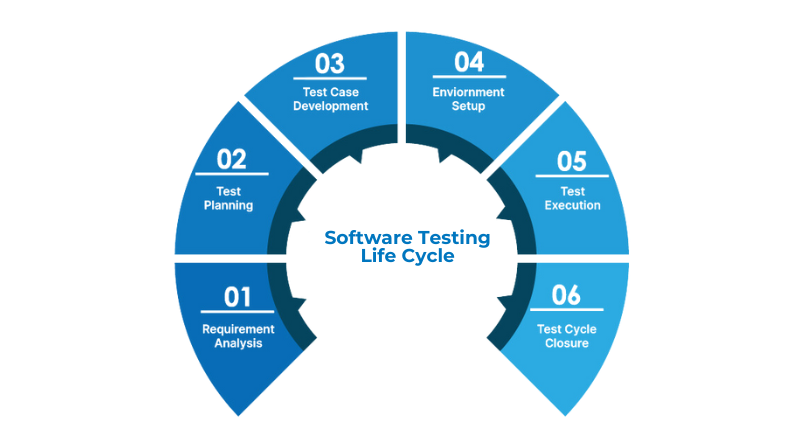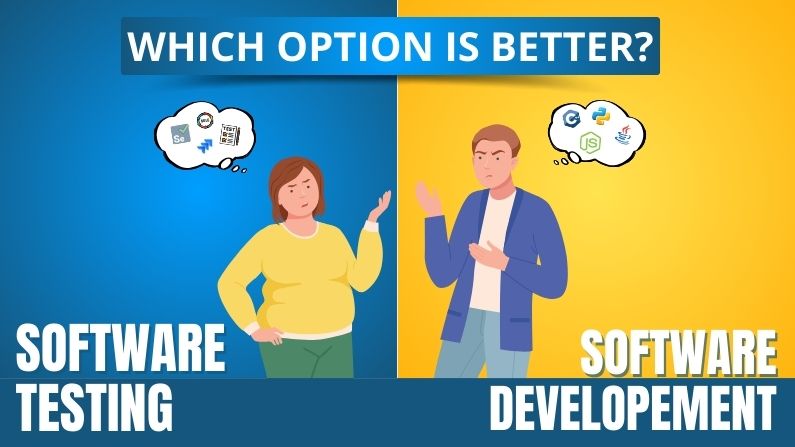
Software Testing Life Cycle your Complete Guide for 2025
What Is the Software Testing Life Cycle?
The Software Testing Life Cycle (STLC) is a step-by-step process that software testers follow to ensure that a software product works as expected. Just like anything that goes through stages of change, Software Testing has its own set of activities that help identify issues and improve the product.
In the STLC, testers check if the Software meets certain requirements. If they find any bugs or errors, they work with the developers to fix them. Sometimes, they even discuss with clients to understand more about the product. The main goal is to validate and verify that the Software is working correctly before it is released to users.
What is the role of STLC for Product development?
The main purpose of the Software Testing Life Cycle (STLC) is to identify errors and fix them, ensuring the product’s quality. Every phase of STLC, from planning to execution and maintenance, is essential for testing a product.
STLC focuses on improving key aspects of an application like reliability, functionality, and performance. This helps create a high-quality product that leads to lower maintenance costs and better stability in the long run. A stable and reliable product not only attracts new users but also keeps existing customers satisfied. To keep a product successful in business, attention to each phase of the STLC is crucial.
To understand whether your product is user compatible check with our testing experts on www.upsurgeinfotech.in check our Testing services for more details.
What are the benefits of Softwarе Testing Life Cycle?
The Software Testing Life Cycle (STLC) provides several benefits that improve the overall quality and efficiency of software or application. Shifting left in the development cycle allows testing to begin earlier, improving test design and clarity in feature areas. Its systematic approach ensures an in-depth knowledge of project requirements, resulting in increased consistency and efficacy in meeting project objectives.
STLC provides clearer spеcifications, which benefits the whole development and testing team by improving understanding and communication. The process enables the early and rapid identification of bugs or defects in the software product, resulting in timely solutions and high quality standards.
What are different Types of Phases in Testing?
To ensure the accuracy and precision of a product, it’s essential to validate every module of the software or application. Since Software Testing is a detailed process, testers follow specific phases to carry it out effectively.
Types of Phrase are:
- Requirement Analysis
- Test Planning
- Test Case Development
- Environment Setup
- Test Execution
- Test Cycle Closure

Every phase of the Software Testing Life Cycle (STLC) has its own objectives and outcomes. It covers the entire process, from starting the test to completing it.
Now, let’s explore the various phases of the STLC in detail.
1. Requirement Analysis
Requirement Analysis is the first phase of the Software Testing Life Cycle (STLC). In this stage, the testing team studies and understands the project requirements. They figure out what needs to be tested and identify the testing priorities.
The goal is to make sure that the testing team is clear about what needs to be done before moving to the next step.
2. Test Planning
Test Planning is the second phase of the Software Testing Life Cycle (STLC). In this stage, the testing team develops a test plan by understanding testing needs and the product’s scope. They set objectives, analyze risks, and outline the testing environment and schedule.
Management then selects the tools, assigns roles, and sets deadlines for each testing phase. The key result of this step is the test plan document, which outlines the testing approach and goals.
3. Test Case Development
After planning, the next phase is to create test cases based on the test plan. Testers develop detailed test cases to cover all possible scenarios, including different combinations and conditions.
Prioritize these test cases by identifying which are most common or have the greatest impact on the product. Test cases are then verified, validated, reviewed, updated, and approved, including any related automation scripts.
This phase also defines test conditions, input data, and expected results. The main output is a set of test cases organized in test suites.
4. Environment Setup
After Test Case Development, the next phase is to run tests effectively, you need certain resources like servers, frameworks, hardware, and software. It’s crucial to perform a smoke test and provide your testers with bug reporting tools. The common phrase “it works on my system but not on yours” shows why a solid test environment is so important.
Your test environment should reflect all the possible scenarios users may face. For example, a feature that works in Google Chrome may not function in Internet Explorer. Or a feature that runs smoothly on a device with 4 GB RAM might encounter issues with just 1 GB. Researching the environments your users use will help you prioritize which setups to focus on.
The goal of this stage is to create a well-planned test environment management strategy.
5. Test Execution
Testing begins once all previous phases are completed and the application is ready. Testers follow the test plan to run test cases, identify defects, and report bugs. They compare the expected results with the actual outcomes, and any bugs found are logged and sent to the development team for fixing.
After a bug is fixed, regression testing is done to ensure the software still works as expected after changes. It’s essential to retest the entire product because fixing one issue can sometimes cause another bug elsewhere.
Since the same tests must be repeated after every fix and deployment, using Automation Testing tools or scripts is recommended. The key result of this phase is the test outcomes, which ideally should be validated and communicated automatically.
You can learn how to execute test cases from our Automation Testing course and learn from the best Software Testing Institute in Mumbai!
6. Test Closure
Test Closure is the last stage in the Software Testing Life Cycle (STLC).
Test closure begins after all testing is completed and the product is delivered. The team reviews the test results and discusses them with the team, focusing on product quality, test coverage, and project cost. If the results differ from the original estimates, further analysis is done to figure out what went wrong.
It’s important for the testing team to meet and review the overall testing process. They can talk about any challenges faced, gaps in strategies, and brainstorm ways to improve the process based on what they learned. If you follow DevOps or use a canary release approach, frequent testing will occur. You can also decide how often to send reports and what details should be included for different stakeholders.
In this phase, the team also looks at metrics, whether the goals were met, and how well deadlines were followed. After a complete review, they can assess the entire testing process and see if any improvements can be made.
If you are interested in learning interesting topics and more about the process of Software Testing and its different concepts, you can connect with our Educational Counsellor NOW. Our team will guide you on how to start your career in Software Testing.
Click the link below to book a career consultation call with our career counsellor now.

















